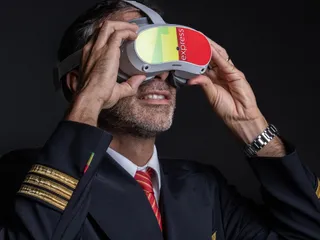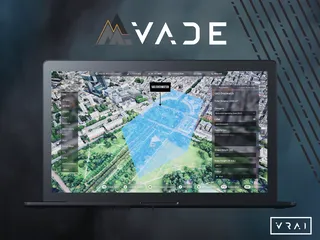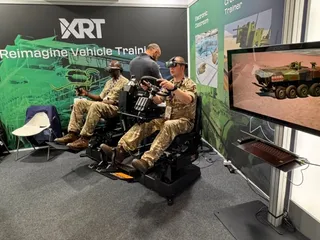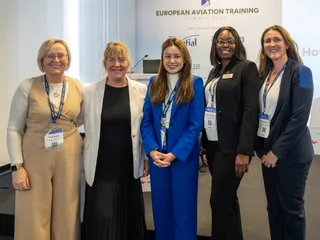XR’s Expanding Presence in Civil Aviation Pilot Training
Contact Our Team
For more information about how Halldale can add value to your marketing and promotional campaigns or to discuss event exhibitor and sponsorship opportunities, contact our team to find out more
The Americas -
holly.foster@halldale.com
Rest of World -
jeremy@halldale.com

A confluence of forces is merging to permit the civil aviation training enterprise to step up its pace to use XR (extended reality), primarily VR (virtual reality) and MR (mixed reality), as a learning enabler. Underpinning technologies for hardware and software are advancing to allow cadets and their operational counterparts to virtually and effectively complete higher fidelity and more diverse scenarios. Early returns on investment on XR-enabled instruction are encouraging ATOs and other training establishments to incrementally expand this technology across the wider learning continuum. Indeed, initial outcomes from use cases for pilots are motivating training organizations to expand XR for maintenance personnel, cabin crew and other community professionals’ learning activities.
Three randomly selected organizations provided insights for this article. While each entity has a unique, different community position there was a common thread in their perspectives: XR has emerged as a force in instructional design with the promise of an ever-wider use of the technology.
Representative Use Cases
Thor Paulli Andersen, co-founder, partner and developer at VRpilot, noted his company is seeing a constant, increasing demand for its solutions in procedure training, especially for new hires at airlines. “The primary uses here are SOP training (including CRM and callouts), flows training, cockpit familiarization and memory items training.” The executive observed VRpilot has also seen VR spilling over into other work functions on the aircraft. This includes maintenance, whose professionals also need to be able to perform procedures in the cockpit, but who are more limited on actual simulator time than pilots. “The norm has been that airlines initially adopt VR for pilot training and then expand it to cover maintenance and/or cabin crew after becoming familiar with the technology and its capabilities, and establishing the infrastructure to handle the hardware,” Andersen added.
To support its expanding customer list, VRpilot focuses on standalone VR headsets. “Our recommended headsets are the Pico 4 Ultra Enterprise and Meta Quest 3. We also support the HTC Vive standalone series, which offers other advantages.”
Andersen then reflected that standalone VR headsets have developed greatly over the past four years, and are now “great devices.” The executive first noted their high-performance results in low latency, thus reducing VR sickness. The devices’ lower weight and better weight distribution also enable longer training sessions before fatigue sets in. High resolution enables a realistic representation of modern flight decks. “The end result is, however, a combination of the way the software is designed, and the hardware,” he said and significantly emphasized, the software needs to make the most of the hardware’s capabilities and create realistic training experiences. “Our software also monitors the user’s time in VR and suggests taking a break if needed. We are looking forward to the next generation of standalone VR headsets which has been initiated by the standards set by the Apple Vision Pro. Increased resolution will enable the users to clearly read small text on the many screens found in today’s modern flight decks.”
Pia Born, Senior Project Manager at Lufthansa Aviation Training, updated the author this October on the quickening pace of activities in her portfolio – with a flurry of developments to report since the author’s last discussion with the LAT team at EATS 2024.
After the introduction of the Virtual Procedure Trainer (VPT) this July LAT’s launch customer, Brussels Airlines, has conducted subsequent type rating training this September and will continue to do so. “The VPT is now an integral part of their A320 syllabus,” the executive initially said. The training expert added that due to the carefully thought-out training concept, the overall transition from the previous system to the new one was largely seamless with parts of the Flat Panel Trainer (FPT) sessions having been replaced by VPT sessions.
Born then provided an important “deep dive” on VPT’s fielding, supplying important lessons learned and insights for others in the broad high-risk community who are contemplating XR-enabled learning.
The executive first pointed out an extensive preparation phase across LAT’s Group-wide project was necessary for:
- developing the software’s content and functionalities to facilitate replacement rather than add-on only;
- smart structuring of lessons to fit the existing curriculum and provide sufficient guidance for autodidactic training without the presence of an instructor (unlike traditional simulator devices);
- providing professional technical support across locations;
- addressing hardware constraints;
- coordinating updates and trouble-shooting;
- meeting IT security and data protection requirements;
- ensuring regulatory alignment and approvals; and
- managing change and acceptance.
Born added LAT is still working on an optimized handling of individual procedures and procedural changes.
LAT’s journey to XR-enabled learning has led it to continuously evaluate VR headsets, such as the Meta Quest 3, to identify the best fit for its respective training solutions. “Currently, our VPT setups are based on PC streaming on standalone VR headsets with controllers via Wi-Fi including hot-swappable battery packs.”
Roger Klingler, CEO at BRUNNER Elektronik AG (BRUNNER), provided unique insights from the perspective of supplying the NOVASIM MR DA42 for civil aviation training and the NOVASIM MR F35, viewed by the author at a recent I/ITSEC, for the military domain. “The same Mixed Reality technology is applied, but the expectations, usage, and training goals differ significantly,” the corporate leader noted.
CEO Klingler first noted the BRUNNER NOVASIM MR DA42 is attracting great interest, with implementation of the product in Europe making steady progress. “The recent FNPT II qualification has been an important milestone to enable the technology particularly because it provided credibility in the professional training market. It shows how the simulator is being recognized for its overall quality and training value.”
At the same time, MR is still a new concept for many training organizations. The executive explained the concept requires adaptation of training methods as well as a willingness from instructors and students to embrace new technology. “The real return on investment will only become visible once more pilots and schools are taking advantage of the benefits of these MR systems and see firsthand how it improves training quality due to immersion and realism compared to conventional simulators.”
Klingler then hit upon a key bottleneck in play on the community’s journey to implement XR-enabled training.
EASA’s Special Conditions successfully qualify pioneering Mixed Reality (MR) devices, but the process is device-specific and resource-intensive. This high-effort, case-by-case assessment acts as a significant barrier for many manufacturers. The executive added, “To enable wider adoption and truly leverage the benefits of MR technology, EASA must urgently shift from bespoke Special Conditions to formal, scalable standards. This will ensure compliance, foster competition, and accelerate the modernization of pilot training.”
ROIs
VRpilot’s Andersen initially addressed his customers’ ROIs from the context of better pilot preparation, lower simulator load, better pass rates, lower extra simulator hours and better quality of training. “We’ve seen customers starting to get accreditation from their respective authorities, which is a huge step forward,” he emphasized.
Back at LAT, at the top of Born’s early ROI list was the observation that Brussels Airlines’ crews have expressed strong appreciation for the new tool, particularly highlighting the content quality and the variety it brings to training delivery. “The immersive VR environment adds realism and interactivity, while the responsive 2-D version available on the pilots’ Electronic Flight Bags (EFBs) allows unlimited practice at home, at their own pace,” the executive explained and added, this dual accessibility has contributed to a faster time to proficiency in procedural flows – pilots arrive at procedure training better prepared with fewer repetitions required to reach the expected standard. And on the quantitative side? While it is too early to publish numbers on the VPT program, “we can confidently say that overall training costs are reduced due to relatively small investment and infrastructure needs (compared to traditional simulator devices). This enabled LAT to offer pilot training in Brussels for the first time and, in fact, we can offer VPT at all LAT training centers fostering flexibility and sustainable traveling.” In a companion ROI, the VR-based VPT module has freed up instructor capacity by effectively replacing traditional SOP indoctrination sessions, allowing instructors to focus on higher-value training interactions.
BRUNNER’s Klingler conveyed another ROI of interest – the hours that can be offloaded from a training- or actual aircraft into a flight training device – the NOVASIM MR DA42 in this instance. The NOVASIM MR DA42, equipped with the Varjo XR-4 Focal Edition headset, can be used as an equivalent training device such as any other on the market with the CS FSTD (A) FNPT II qualification. “By adding additional cues and realism to the simulator we inspire decision makers and flight instructors to rethink their training strategies,” the CEO said and continued, “By shifting these hours into the highly realistic mixed reality environment, flight schools can significantly reduce aircraft operating costs while maintaining or even improving training quality. A good visual system is a main factor to this capability. Its unmatched fidelity in Mixed Reality, amplified by a 6-DoF motion system, immerses cadets in a cockpit environment that feels nearly identical to the real aircraft, enabling training for a wide range of critical tasks. This includes full scenarios like taxying, executing checklists, practicing approaches and landings, as well as circuit flying and emergency procedures.” The integration of the Electronic Flight Bag further supports procedural training and helps students develop authentic “muscle memory” before moving to the actual aircraft.
Buckle Up for the Road Ahead
The three organizations’ business plans and insights gained from other teams the author earlier met with, point to a steady and expanding use of XR in civil aviation pilot training – with the promise of more use cases on the horizon.
Earlier this year, VRpilot acquired the assets of a now defunct company which specialized in cabin crew VR training. Andersen reflected that the acquisition will add cabin crew training to his company’s portfolio on the same well-proven platform that now serves pilots and maintenance across its many customers. “Other activities in our roadmap include adding more aircraft types to our portfolio – both airliners, business aircraft and light aircraft.”
LAT is similarly positioned to increase its VR-enabled instructional capacity beyond 2025. Born indicated this learning technology project plan calls for deliberate, incremental but expanded
implementation in different stages. While VR training at Brussels Airlines is up and running, the responsible training team is rolling out the instructional design with other LHG airlines at additional LAT locations across the DACH region. “We still expect at least three more airlines to implement this year, and we will continue to add airlines in 2026,” the training manager added. And while the headquarter training team’s primary focus this year has been on supporting normal procedures for the A320 and refining course content based on user feedback and modifications identified in test cases, the training leader concluded, “LAT plans to expand content and fleet scope to cover abnormal / supplementary procedures as well as other aircraft types, depending on LHG airlines’ needs.”
BRUNNER’s Klingler told CAT his company’s roadmap for MR/XR-enabled training includes new projects and ideas, though the Switzerland-based company is not yet ready to reveal details. The CEO concluded, “what matters is that at BRUNNER we never stop striving for innovation, not to be simply ahead in technology, but to solve real world problems in aviation training. The NOVASIM MR DA42 proved what’s possible, and it’s only the beginning. The runway ahead is long and we fully intend to keep accelerating.”
On Our Editorial Watch List
Civil aviation training organizations across the globe are increasing their XR-enabled learning activities. This article provided a glance at programs in the community’s pilot training segment. Concurrent efforts are also gaining speed to use this technology in instructional design strategies for cabin crew, maintenance technicians and other professionals. CAT will follow and comment on these training developments as important milestones are achieved.


